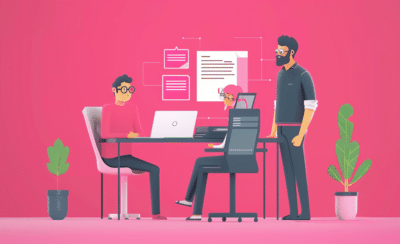When designing your site, it’s essential to know what’s up—industry-wise—and keep track of prevailing B2B website UX/UI trends.
Well, fear not; with experience designing and deploying hundreds of these things, Goji Labs is up-to-date on all things UX/UI design. And we’re here for you.
So, we’ve compiled a handy listicle on today’s top B2B website UX/UI design trends.
Let’s get started.
TLDR; Contents
Generally Essential B2B Website UX/UI Design Features
1. System Status Orientation
It’s always important to orient your user, especially when it comes to system functionality. For example, there’s a reason that rainbow “circle of doom” is so dreaded for Mac users—the system is loading or freezing, but you get no information about what’s about to happen or how long it’ll take.
There are a few imperative features to use that keep your user oriented on your B2B website:
- Progress bars
- Thank you pages
- Confirmation pages
- Highlighted previously selected menu options
- Page headers (good for SEO too)
- Sticky navigation menus
- Breadcrumbs (a map that tells your buyer where they are and where they’ve been on your website)
For background, breadcrumb navigation works like a map that tells your users where they are on your website and where they’ve been.
2. Lessening Your User’s Memory Load
Part of ease-of-use—a tremendously important theme in creating your B2B website—is basing your website’s functionality on recognition rather than recall. Ergo, don’t make your users remember things—rather, embed reminders of previous pages or dialogue screens in the next. Your buyer needs to know the next steps while they’re completing the current ones and need to know what to do next quickly.
There are a few features you should use to lessen the memory load of your buyer.
- Sticky menus—which prevail again! Sticky menus help your user stay oriented and know where to go next. They should be able to access a navigation menu or tabbed content wherever they are on the page.
- Accordions—which are especially useful in FAQs. Accordions should address whatever you might think are top concerns for your users, divided into categories. This way, they can drop down what they need and minimize what they don’t. Doing so eliminates endless scrolling or scanning pages back and forth to find the elements your buyers are looking for.
Another important aspect of accordions is to match the wording your buyers use to describe their searches—which you should find out through existing buyer relationships, surveys, and keyword research.
- Color changing previously visited links or elements—which help orient the buyer in your website by marking where they’ve already been and can remind them of where they need to go next.
3. Confusion-Reducing Error Messages
Errors happen on every website—and they’ll happen to yours, too. So, whether it’s no longer active pages, redirects, or invalid search bar results, your error messages should explain what happened.
Moreover, to eliminate any potential frustration, they should offer helpful solutions (a redirect to the home page, a suggestion for a related page, FAQ, or chatbox link, etc.) Additionally, if it’s relevant to your branding, they can incorporate humor into the solutions: memes, funny pictures of animals, or puns—you name it. You want to avoid inspiring confusion and frustration in your buyers however you can. And showing some humility with “derpy” goats, along with a solution.
4. Responsive Design and Optimization for User Devices
Speaking of eliminating frustrations in users—there are few things more annoying than trying to access a website that isn’t optimized for one’s device. Therefore, it’s essential to stay on top of which devices are most prevalently used by your buyers and optimize for them.
For instance, with work-from-home blowing up as it did in the last few years, many people are upgrading work devices to large monitors—many of which now feature 1080p resolution.
Therefore, incorporating responsitivity for high-resolution screens is essential—especially in the B2B space. In addition, for B2B websites, most visitors (i.e., business buyers) will be accessing your website on computers rather than mobile devices. Therefore, the optimal B2B website design will allow for flexibility that accommodates multiple viewports.
Additionally (and seemingly contradictory): at this point, mobile phones generate a smidge more than half of the total website traffic. And so, while B2B website visitors favor desktops, it’s also essential to optimize for the mobile devices that access your website. A tool to use here could be Scalable Vector Graphics (SVG) for mobile, scalable images that can relieve slow page-load times or quality deterioration of JPEG, PNG, and GIF image formats.
5. Personalized Navigation
Depending on your business, you might receive various types of visitors, each with their role and perspective in whatever supply chain you’re participating in. If you provide persona-based site navigation, you can tailor and streamline their website experience. Remember the point on ease-of-use? With personalized navigation, you’re helping your different visitors get to where they want as quickly as possible—making their lives easier and making conversions easier as well.
B2B Website UX/UI Design Trends of 2021
Alrighty. Now that we’ve covered some generally essential B2B website UX/UI design features, let’s switch over to B2B website UX/UI design trends that are hip and hopping right now.
1. Combining Content Types
First off in our list of B2B website UX/UI design trends is mixing up content pieces. These days, no visitor has the patience to read giant blocks of text. So, it’s essential to keep them engaged with different forms of media: written, visual, infographics, and videos, animations, and illustrations. Using the latter to communicate your value proposition will help visitors stay attentive and understand what you’re all about.
2. Microinteractions and Microanimations
Microinteractions and microanimations are more B2B website UX/UI design trends your visitors may expect, given both experiences with other B2B websites and websites with which they interact on a personal basis.
You can incorporate microanimations in as they’re hovering over different links and features or in your calls-to-action. Either way, using these allows your user to get instant feedback on what they’re doing on your website and creates an immersive experience.
Of course, it’s important to use them tastefully, without bombarding or distracting your buyer. Moreover, it’s essential to consider page-load times—so your designers and engineers should be aware of which video formats and coding they’re implementing. But, done well, microinteractions and microanimations can drive engagement, inspire buyer confidence, and boost conversion.
3. Evolving from Skeuomorphism to Neumorphism
Skeuomorphism was long the prevailing design strategy in graphical user interface design to describe interaction objects that look and act similar to their real-world counterparts. For example, the recycle bin icon that symbolizes deleting files or buttons designed to look like actual, 3D, and plasticky real-life buttons to convey their functionality.
Neumorphism, on the other hand, is a minimalistic, flatter, visual aesthetic that emphasizes the critical features and functionalities of websites. Neumorphism eliminates visual clutter and keeps the buyer focused on the elements you want them to know and use. And it’s becoming the prevailing modern aesthetic choice.
4. Minimalism
In a beautiful segue from neumorphism, the minimalist aesthetic is taking a huge stake in B2B website UX/UI design trends. A study by Google has found that visually complex websites are consistently less appealing to buyers than those that are polished and minimal.
Minimalism can play a role in everything from branding, design, and functionality. For instance, take a field in which your buyer has an option to personalize their experience or search. You could provide a list of linked options to each option—or, rather, install a search bar with auto-fill-in and suggestions. One of these options can be messy, heavy on the eyes, and challenging to use. In contrast, the other streamlines the whole process while keeping a clean aesthetic.
5. …But Also Using Textures and Patterns
So, while minimalism is taking flight, it doesn’t include still providing an engaging experience. By incorporating textures, patterns, and overlays in visuals, you’ll be able to make elements stand out and disrupt the visual flow—keeping your visitor engaged (quickly informed, but not bored.)
6. 3D Design and Video
By adding floating visual components and adding soft shadowing to design elements, you’ll be able to attract the eyes of visitors to the essential features of your B2B website. Additionally, 3D elements and videos can help you stand out from competitors by upscaling your design. Done well, even if the actual implementation of 3D elements might not be so much complex, it’ll look that way.
7. Dark Mode
The dark mode is another B2B website UX/UI design trend that is very quickly catching on. With dark mode, you can deliver impactful messaging of your most essential elements with high-contrast coloring—but it’s also generally easier on the eyes of visitors that are probably looking at screens a lot throughout their days.
8. Augmented Reality
Finally, on our list of B2B website UX/UI design trends, we have augmented reality. Because how could we not? Augmented reality is so helpful in buyers’ decision-making, especially when it comes to tangible solutions or that streamline processes for buyers.
There are many examples of B2B companies incorporating augmented reality into their websites. But, in cases in which buyers will need to physically interact with your product, this tool will immediately help them visualize the place of your product in their environments.
Well, this was a lot. We know. So, it could be beneficial to consult product strategy experts who’ll help you put the theory to the rubber.
Coincidentally, hi, we’re Goji Labs—a product and software development consultancy with experience in designing, “rescuing,” and deploying hundreds of products.
Looking to develop a new app or revamp an existing one?
Have any general questions about who we are and our authority on the subject?
Reach us at GojiLabs.com.
– Goji Labs




